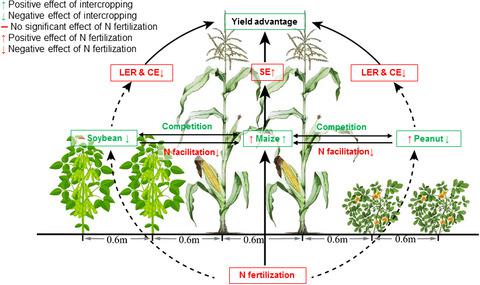当前位置:
X-MOL 学术
›
J. Appl. Ecol.
›
论文详情
Our official English website, www.x-mol.net, welcomes your
feedback! (Note: you will need to create a separate account there.)
Shifts from complementarity to selection effects maintain high productivity in maize/legume intercropping systems
Journal of Applied Ecology ( IF 5.0 ) Pub Date : 2021-08-10 , DOI: 10.1111/1365-2664.13989 Wei‐Ping Zhang 1 , Sai‐Nan Gao 1 , Zhao‐Xin Li 1 , Hua‐Sen Xu 1 , Hao Yang 1 , Xin Yang 1 , Hong‐Xia Fan 1 , Ye Su 1 , Dario Fornara 2 , Long Li 1
中文翻译:

在玉米/豆类间作系统中,从互补性到选择效应的转变保持了高生产力
更新日期:2021-08-10
Journal of Applied Ecology ( IF 5.0 ) Pub Date : 2021-08-10 , DOI: 10.1111/1365-2664.13989 Wei‐Ping Zhang 1 , Sai‐Nan Gao 1 , Zhao‐Xin Li 1 , Hua‐Sen Xu 1 , Hao Yang 1 , Xin Yang 1 , Hong‐Xia Fan 1 , Ye Su 1 , Dario Fornara 2 , Long Li 1
Affiliation

|
- Complementarity (CE) and selection effects (SE) have been either invoked to explain the positive diversity–productivity relationship in natural and semi-natural ecosystems. Few studies have, however, separated selection and complementarity effects in economically valuable intercropping systems, which receive significant nutrient inputs throughout the growing season.
- We performed a 2-year field experiment with five cropping systems (i.e. maize/peanut intercropping, maize/soybean intercropping, maize, peanut and soybean monocultures) under different combinations of nitrogen (N) and phosphorus (P) fertilization. Sequential harvest of subplots was performed five times during the growing season and the additive partitioning method was applied to determine complementarity and selection effects in the two intercropping systems.
- We found that the land equivalent ratio (LER) based on yield was greater than or close to 1 in both maize/soybean and maize/peanut intercropping systems, suggesting yield advantages in these intercropping systems compared to monocultures. The LER of the two intercropping systems without N fertilization was greater in 2018 than in 2017. Nitrogen fertilization reduced the LER of maize/soybean intercropping in 2018, and that of maize/peanut intercropping across 2 years. Nitrogen fertilization had much stronger effects on maize yield than on soybean or peanut yield. Intercropping increased maize yield but decreased soybean and peanut yield.
- The CE was more important for net biodiversity effects without N fertilization while the SE was more important with N fertilization in the two intercropping systems across 2 years. Phosphorus fertilization impacts on the LER and biodiversity effects were weaker compared to N fertilization. Finally, net biodiversity effects were greater at later growth stages within a growing season.
- Synthesis and applications. Our study demonstrates how yield advantages of species-diverse intercropping systems can be maximized either through (a) CE in the absence of N fertilization thanks to complementarity in nutrient use between crops or (b) SE under N fertilization thanks to overyielding of highly productive species (i.e. maize). Yield advantages promoted by CE are more sustainable because they are associated with reduced chemical fertilizer use and greater monetary benefits to farmers. These findings have important implications for the design and management of species-diverse intercropping food-production systems.
中文翻译:

在玉米/豆类间作系统中,从互补性到选择效应的转变保持了高生产力
- 互补性 (CE) 和选择效应 (SE) 已被用来解释自然和半自然生态系统中积极的多样性 - 生产力关系。然而,很少有研究在具有经济价值的间作系统中分离选择和互补效应,这些系统在整个生长季节接受大量养分输入。
- 我们在不同的氮 (N) 和磷 (P) 施肥组合下对五种作物系统(即玉米/花生间作、玉米/大豆间作、玉米、花生和大豆单作)进行了为期 2 年的田间试验。在生长季节连续收获子地块 5 次,并应用加法划分方法来确定两个间作系统的互补性和选择效果。
- 我们发现,在玉米/大豆和玉米/花生间作系统中,基于产量的土地当量比 (LER) 大于或接近 1,表明这些间作系统与单一栽培相比具有产量优势。2018 年未施氮的两种间作系统的 LER 均高于 2017 年。 施氮降低了 2018 年玉米/大豆间作的 LER,以及 2 年间玉米/花生间作的 LER。氮肥对玉米产量的影响远大于对大豆或花生产量的影响。间作提高了玉米产量,但降低了大豆和花生产量。
- 在 2 年的两个间作系统中,CE 对于没有施氮的净生物多样性影响更为重要,而 SE 对于施氮更为重要。与施氮相比,施磷对 LER 和生物多样性的影响较弱。最后,在生长季节的后期生长阶段,净生物多样性影响更大。
- 合成与应用。我们的研究证明了如何通过 (a) 由于作物之间养分利用互补而在没有施氮的情况下的 CE 或 (b) 由于高产物种的过度生产而在施氮下的 SE 来最大化物种多样性间作系统的产量优势(即玉米)。CE 促进的产量优势更具可持续性,因为它们与减少化肥使用和为农民带来更大的经济利益相关。这些发现对不同物种间作粮食生产系统的设计和管理具有重要意义。











































 京公网安备 11010802027423号
京公网安备 11010802027423号